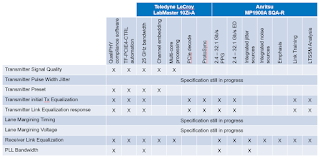 |
| Figure 1: A key element in PCIe 4.0 compliance test is a high-bandwidth, real-time oscilloscope (shown is the Teledyne LeCroy LabMaster 10Zi-A) |
The element common to all of the tests in the PCIe 4.0 test specification is a high-bandwidth, real-time oscilloscope. The required bandwidth for Card ElectroMechanical (CEM) specification testing is stipulated by PCI-SIG in the test specification itself. For PCIe 3.0, the stipulated oscilloscope bandwidth is 13 GHz, and that rises to 25 GHz for PCIe 4.0.
We recommend our LabMaster 10Zi-A, which is nominally a four-channel instrument with real-time bandwidth of 25 GHz and sampling rate of 80 GS/s. The LabMaster 10Zi-A provides an upgrade path to bandwidths of 36, 65, and 100 GHz, future-proofing any subsequent PCIe 5.0 development needs.
Whether it's the LabMaster 10Zi-A or another oscilloscope that will be the centerpiece of your PCIe 4.0 testbench, it needs to have a rather robust feature set if it's to truly satisfy the test requirements. These features include:
- Integrated eye-diagram and jitter analysis tools
- Channel embedding and test-fixture de-embedding
- PCIe decoding with waveform annotation and tabular analysis
- Features for higher-level protocol decoding
- Multicore CPU for parallel processing capabilities
 |
| Figure 2: Anritsu's MP1900A BERT is fully equipped for PCIe 4.0 (and 5.0) receiver tests |
PCIe 4.0 receiver tests require a similarly well-equipped bit error-rate tester (BERT). One such instrument is Anritsu's MP1900A signal-quality analyzer, a multi-channel BERT with support for all earlier PCIe generations (Figure 2). Like the LabMaster 10Zi-A, the MP1900A also provides enough horsepower for the upcoming PCIe 5.0 test specification.
The MP1900A supports bit rates from 2.4 Gb/s to 32.1 Gb/s across up to 16 channels while also offering the requisite facilities for link training and equalization as well as link-training and status state machine (LTSSM) analysis. It provides all equipment necessary for PCIe testing: synthesizer, jitter generator, noise generator, pulse pattern generator, and error detection. Thus, no other external test equipment is required.
 |
| Figure 3: PCIe 4.0 testing requires powerful test-automation software (shown is Teledyne LeCroy's QualiPHY PCIe4-Tx-Rx) |
Test fixtures are also central to most, if not all, protocol compliance testing. When it comes to PCIe, test fixtures are available only from PCI-SIG itself. Note that for PCIe 4.0 testing, there are new fixtures, and you won't be able to press any existing PCIe 3.0 fixtures into service.
 |
| Figure 4: This table shows how the test system's elements map to the PCIe 4.0 test specification |
Figure 4 wraps things up with a table showing how the capabilities of the LabMaster 10Zi-A oscilloscope and MP1900A bit error-rate tester map to the equipment requirements of the PCIe 4.0 test specification.
Our next installment will provide a detailed look at the transmitter electrical tests.
Earlier posts in this series:
Introduction to PCIe 4.0 Electrical Compliance Test
3 comments:
Your blog provided us with valuable information to work with. Each & every tips of your post are awesome. Thanks a lot for sharing. Keep blogging.. elektricien apeldoorn
I recently came across your blog and have been reading along. I thought I would leave my first comment. I don't know what to say except that I have enjoyed reading. Nice blog. I will keep visiting this blog very often. Whittier Electrician
I’ve been searching for some decent stuff on the subject and haven't had any luck up until this point, You just got a new biggest fan!.. Mawa Gujiya
Post a Comment